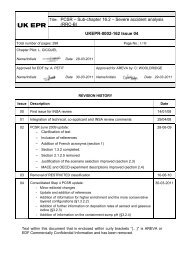14.7 - Fault and Protection Schedule - EDF Hinkley Point
14.7 - Fault and Protection Schedule - EDF Hinkley Point
14.7 - Fault and Protection Schedule - EDF Hinkley Point
Create successful ePaper yourself
Turn your PDF publications into a flip-book with our unique Google optimized e-Paper software.
PRE-CONSTRUCTION SAFETY REPORT<br />
CHAPTER 14: DESIGN BASIS ANALYSIS<br />
SUB-CHAPTER : <strong>14.7</strong><br />
PAGE : 11 / 48<br />
Document ID.No.<br />
UKEPR-0002-149 Issue 02<br />
3.2.1. Control I&C functions<br />
The control I&C functions are those functions, which act on controlled parameters in order to<br />
follow control setpoints in all plant conditions.<br />
Control I&C functions are Non-Classified (NC)<br />
3.2.2. LCO surveillance I&C functions<br />
The LCO surveillance I&C functions are those functions which are implemented to initiate<br />
(manually or automatically) in cases of violation of LCO. The functions contribute to maintaining<br />
the initial conditions within the limits adopted in the safety analyses.<br />
3.2.3. Limitation I&C functions<br />
The limitation I&C functions are functions which are implemented to initiate corrective measures<br />
(manually or automatically) in case the operating point comes too close to the protection system<br />
thresholds (avoidance of protection action).<br />
The main objective of these functions is to improve the plant availability by terminating abnormal<br />
transients at an early stage in order to avoid actuation of a protection action.<br />
The beneficial effect of limitation functions is not taken into account in safety analyses, under the<br />
rules applied in accident analysis. However credit for their role can be taken in probabilistic<br />
studies of certain transients.<br />
3.2.4. <strong>Protection</strong> I&C functions<br />
The protection I&C functions are functions which are implemented to mitigate the consequences<br />
of a Postulated Initiating Event (PIE) automatically after its detection. They include automatic<br />
actuation of protection actions <strong>and</strong> safety-grade systems, <strong>and</strong> automatic control of these actions<br />
during the short term accident phase. This phase is considered to last for 30 minutes after the<br />
occurrence of the first significant alarm following detection of the PIE.<br />
The short term phase is the time period where the protection actions must be automatic. The<br />
EPR design is that automation of the protection actions should enable the controlled state to be<br />
reached after an accident, <strong>and</strong> to be maintained as long as it is required for safety purposes.<br />
Therefore there is no reliance on operator action to bring the plant to a safe stable state, manual<br />
actions being required to transfer the plant from the controlled state to the safe shutdown state.<br />
The above requirements ensure automation of protection functions in the short term postaccident<br />
phase, but do not mean that beneficial operator actions are precluded: beneficial<br />
manual actions either to anticipate automatic actions, or to improve the mitigation level, are<br />
desirable, <strong>and</strong> these are permitted when they are in accordance with emergency operating<br />
guidelines.<br />
3.2.5. Post accident management I&C functions<br />
The post-accident I&C functions are the functions required to bring the plant from the controlled<br />
state to the safe shutdown state <strong>and</strong> to maintain it.<br />
In the safety analyses, a manual action from the main control room cannot be credited within the<br />
30 minutes after the first significant information given to the operator.














![6.3 - Safety Injection System (RIS [SIS]) - EDF Hinkley Point](https://img.yumpu.com/42739985/1/184x260/63-safety-injection-system-ris-sis-edf-hinkley-point.jpg?quality=85)


